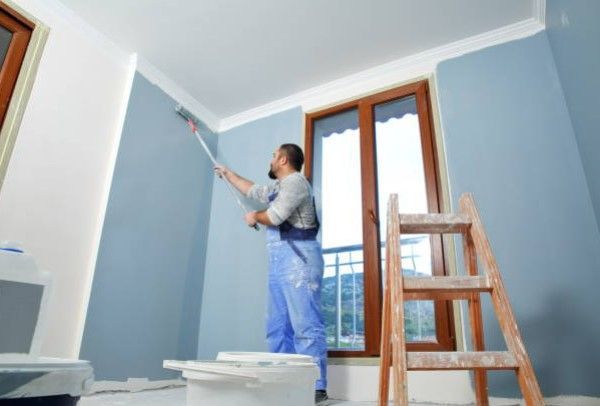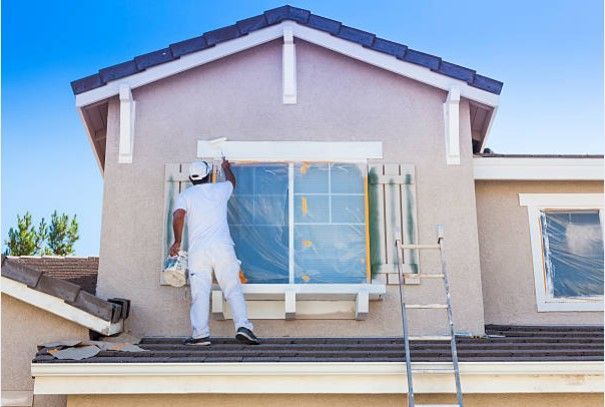Painting 101: Tips for Successful Painting Projects
Transform your home with the important part of home improvement - painting. By mastering proper techniques, you can achieve professional results on walls, ceilings, accent walls, and murals.
This blog covers selecting paint type, finish, colour, surface preparation, efficient paint application, time management, safety, cleaning, maintenance, and creative ideas for a welcoming environment.

Selecting the Right Paint
Different paint types offer varying durability and moisture resistance. Consider the intended use of the painted surface, such as high-traffic areas, bathrooms, or decorative accent walls, when selecting the best paint for the bathroom ceiling.
Here are more tips for selecting the right paint for your walls:
1. Know Different Types of Paint
Choosing the right paint type is essential for achieving the desired results in your home improvement projects. The different types of paint include:
- Latex Paint: It's a water-based paint, popular for interior and exterior surfaces due to its quick drying, low odour, and easy cleanup with water. It works well on walls, ceilings, and most other surfaces.
- Oil-Based Paint: It's durable for high-traffic areas and trim, has a strong odour, longer drying time, and requires paint thinner for cleanup.
- Acrylic Paint: It's versatile, quick-drying, durable, easy to clean. Best for interior and exterior surfaces.
- Chalk Paint: It's matte, velvety finish, adhesive, and ideal for furniture and decorative projects. Chalk paint offers a distressed and vintage look.
- Milk Paint: It's a non-toxic and eco-friendly option, available in powder form that requires mixing with water. This option is commonly used for furniture and craft projects to achieve a unique, rustic appearance.
2. Choose the Right Finish
Opt for the appropriate paint finish based on the desired look and functionality. MasterClass shares an article about the different types of paint finishing, including:
- Matte Finish
- Eggshell Finish
- Satin Finish
- Semi-Gloss Finish
- Gloss Finish
- High-Gloss Finish
3. Test Colour Samples
Always test paint colour samples on the actual surface before deciding. According to an article, lighting conditions and surrounding colours can significantly impact how a paint colour appears in different areas of your home.
4. Check Paint Quality
Invest in high-quality paint to ensure better coverage, durability, and long-lasting results. Premium paints may have a higher upfront cost but often require fewer coats, providing a more satisfactory finish in the long run.
Preparing Surfaces for Painting
Preparing surfaces before painting is crucial for achieving flawless and long-lasting results in your home improvement projects. Whether you're updating walls, ceilings, or other surfaces, proper cleaning, repairing, and priming significantly impact the final outcome.
How to Clean and Prepare Surfaces
- Remove dust and debris.
- Wash with mild detergent.
- Patch holes and cracks.
- Sand the surfaces.
- Tape and cover areas that aren't included for painting.
Fixing Flaws and Applying Primers
- Repair dents or scratches with the appropriate filler or patching compound.
- Apply a coat of primer to promote better paint adhesion and prevent stains from bleeding through the paint.
- Lightly sand the primed surfaces to create a smooth base.
- Before painting, use a stain-blocking primer to cover water stains, ink marks, or other discolorations.
- Allow sufficient drying time for the primer before starting the painting process.
Applying Paint Like a Pro
Applying paint like a pro involves mastering various techniques to achieve a smooth and professional finish. Here are essential tips for brushwork, rolling, and cutting in:
Brushwork
When using a paintbrush, start with the edges and corners of the surface before applying paint to larger areas. Use long and even strokes to prevent visible brush marks and ensure a consistent application.
Rolling
Use a paint roller for larger surfaces like walls and ceilings. Roll in a "W" or "M" pattern to distribute the paint evenly and avoid lines or streaks. Overlap each section slightly to create a seamless finish.
Cutting In
It involves painting along the edges and corners where a roller cannot reach. Use a high-quality angled brush and steady hands for precise and clean lines. Take your time to achieve sharp edges and minimize mistakes.
Tips to Achieve Efficient Paint Application
- Thin coats.
- Proper drying time.
- Blend the edges of the wet paint with the new stroke.
- Work from top to bottom.
- Use a paint grid or tray liner when rolling.
- Keep a wet edge.
Time Management and Budgeting
Time management and budgeting are vital aspects of successful home improvement projects. Here's how to effectively manage your time and budget:
Creating a Realistic Project Timeline
- Plan Ahead
- Prioritize Tasks
- Set Milestones
- Buffer Time
- Regular Monitoring
Budgeting Tips to Avoid Overspending
- Have an overall budget for the project and allocate specific amounts for materials, labour, and other expenses.
- Shop around for the best prices on materials and services.
- Set aside a contingency fund for unexpected costs or changes in the project.
- Evaluate whether specific tasks can be done as DIY projects to save on labour costs.
- Stick to the original project scope.
Cleaning and Maintenance
Cleaning and maintaining painted surfaces properly are essential for preserving the beauty and longevity of your home's appearance. Here's how to keep your painted surfaces looking their best:
Post-Painting Cleanup Tips
- Clean Tools Immediately
- Dispose of Paint Waste Properly
- Wipe Down Surfaces
- Remove Painter's Tape Carefully
Maintenance
- Regular Cleaning
- Touch-Up as Needed
- Address Issues Promptly
- Avoid Excessive Moisture
- Avoid Direct Sunlight
- Repaint as Needed
Creative and Decorative Elements
Creative and decorative elements can elevate the aesthetics of your home and add a personalized touch to your living spaces. Here are some inspiring ideas to consider in decorating your home from an article published by Foyr:
Accent Walls
- Opt for a bold, contrasting colour that complements the room's overall colour scheme.
- Choose walls with interesting architectural features that naturally draw attention, such as behind a bed, fireplace, or entertainment center.
- Experiment with textured paints or wallpaper to add depth and dimension to your accent wall.
Incorporating Patterns, Murals, and Art Gallery Displays
- Use stencils or painter's tape to create geometric or intricate patterns on your walls.
- Hire a mural artist to create a stunning custom mural that reflects your style and interests.
- Place your favourite artwork and photographs by creating a gallery wall.
- Experiment with faux finishes like marble, woodgrain, or metallic effects.

Elevate Your Space Today With Professional House Painters
Seeking professional house or commercial painters is beneficial if you have large-scale projects, extensive surface preparation, tight schedules, high ceilings, difficult-to-reach areas, specialized techniques, and large commercial properties. You can achieve exceptional results and transform your spaces into inviting and aesthetically pleasing environments.
Frequently Asked Questions
-
How long should I wait between coats?
How long should I wait between coats?
The waiting time between coats can vary based on the type of paint you're using:
- Latex Paint: Typically, you should wait 2 to 4 hours before applying a second coat.
- Oil-Based Paint: You might need to wait 24 hours before the second coat can be applied.
Always check the manufacturer’s instructions for the specific paint you're using, as drying times can vary by brand and environmental factors like humidity and temperature.
-
What should I do with leftover paint?
With leftover paint, you can keep a small amount for future touch-ups, ensuring it's sealed tightly and stored in a cool, dry place. Other options could be checking if your local waste management or recycling centers accept leftover paint. But, if it's unusable and recycling isn't an option, follow your locality's guidelines for proper hazardous waste disposal.
-
How do I fix drips or runs in my paint?
To fix drips or runs in your paint:
- Let it dry, and wait for the paint to dry completely. Attempting to fix it while it's wet can make it worse.
- Sand it down, and once dry, use fine-grit sandpaper to sand the area until it's smooth and even with the surrounding surface.
- Wipe down the sanded area to remove all dust and debris.
- Touch up the sanded area with a small amount of paint, using a brush or roller for a seamless finish.
MENU
GET IN TOUCH
604-239-7881
10070 Brentwood Dr, Chilliwack, BC V2P 6G3
info@frasercanyonpainting.com
Chilliwack, Abbotsford, Maple Ridge, Mission & Hope, BC
GET CONNECTED
Contact Us today!
Contact Us
We will get back to you as soon as possible
Please try again later
Fraser Canyon Painting © 2022 | All Rights Reserved
